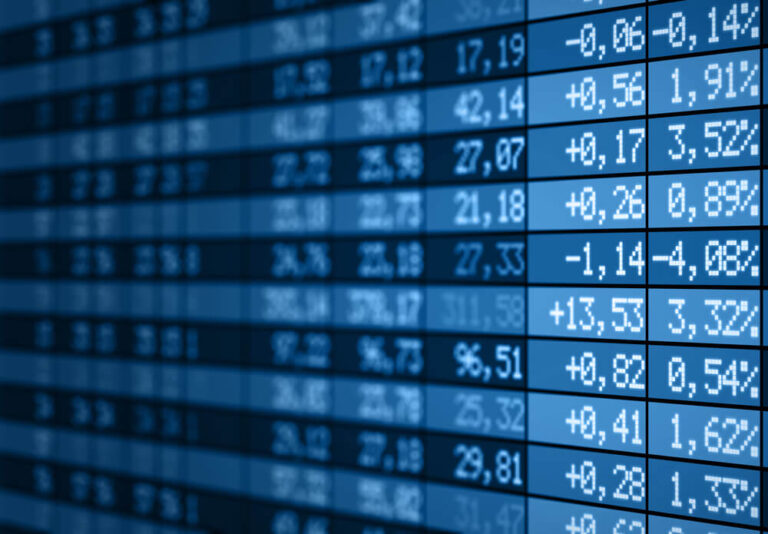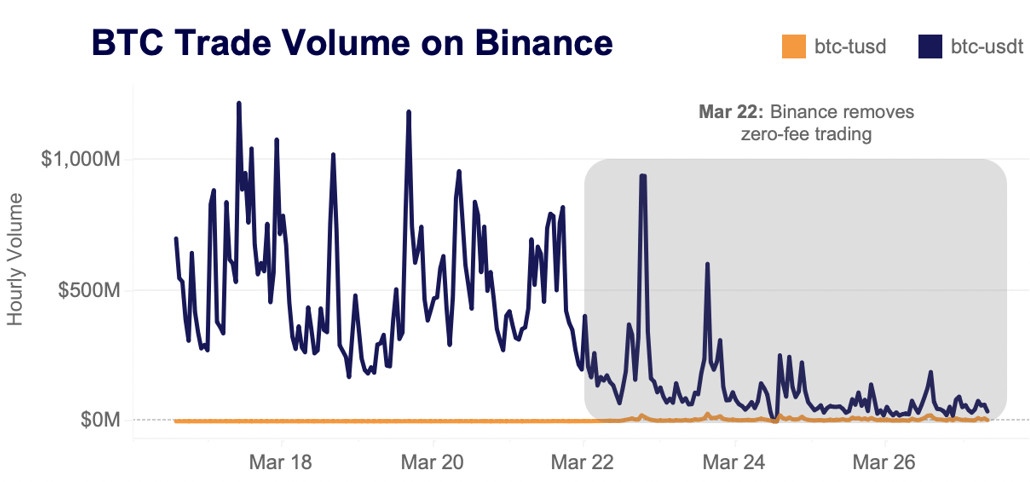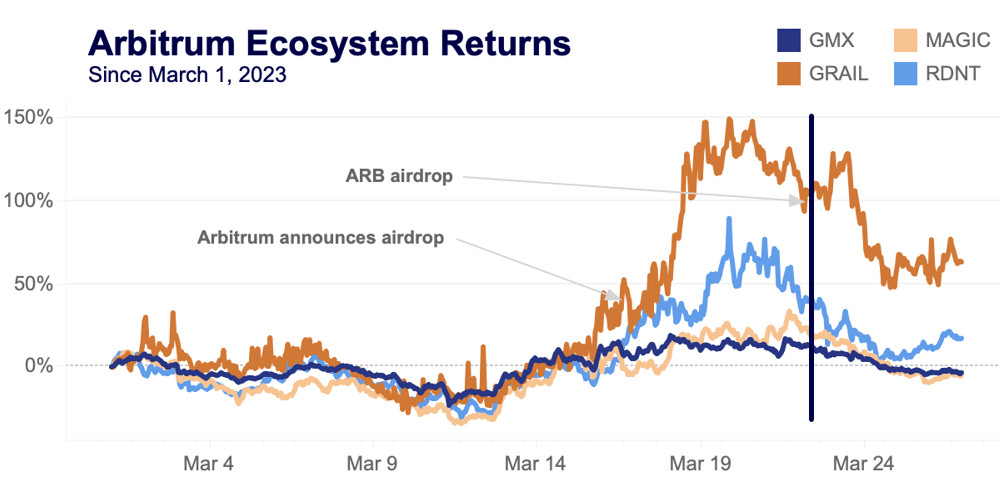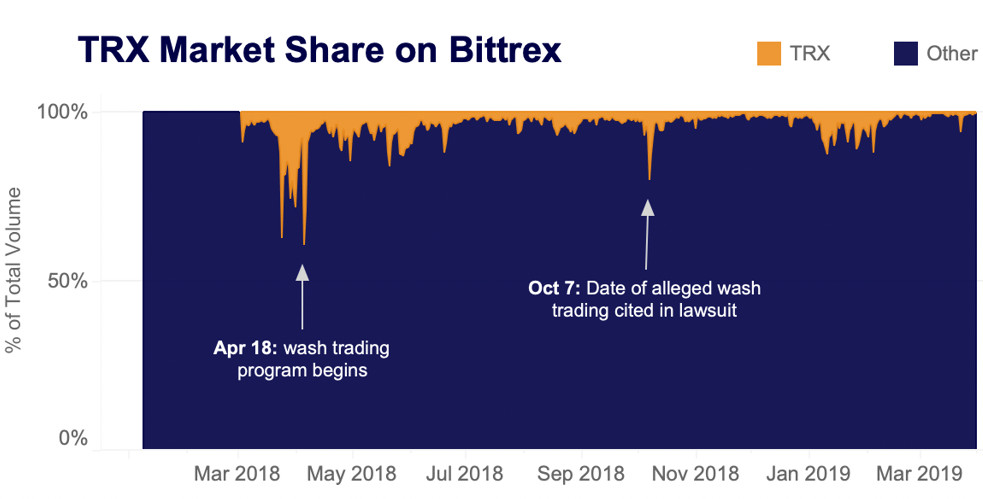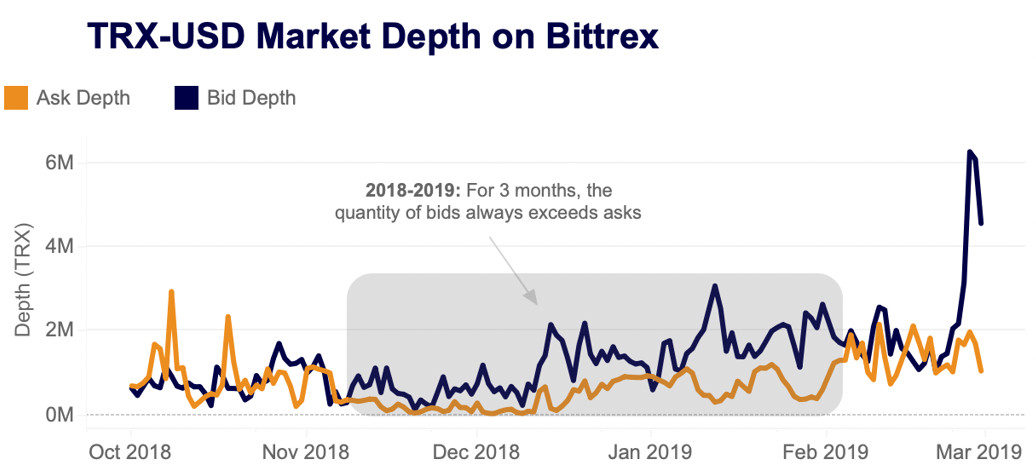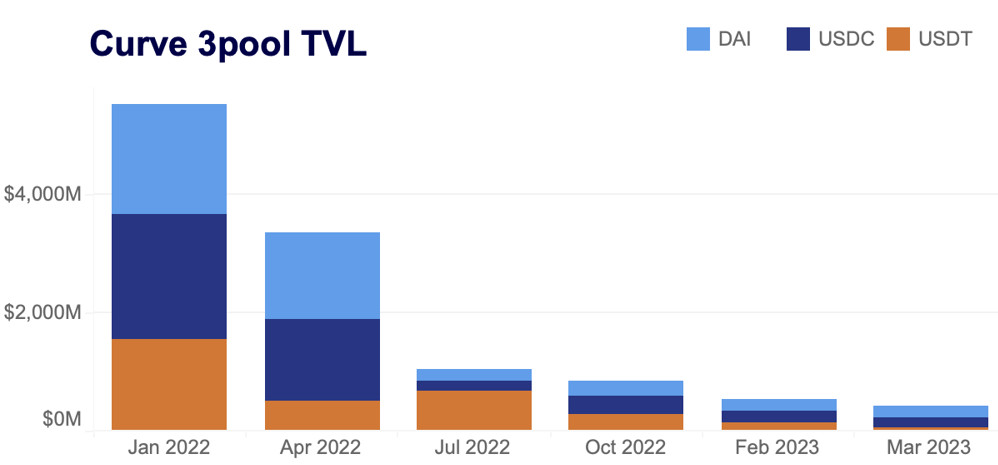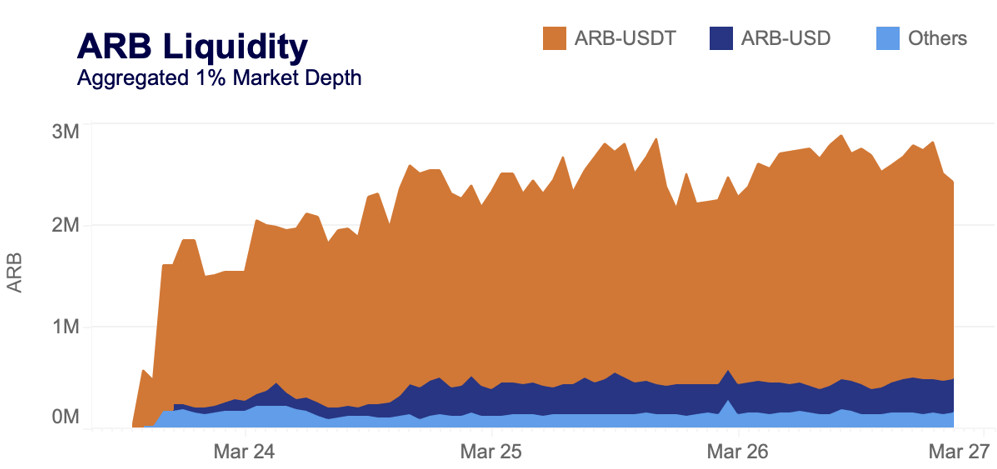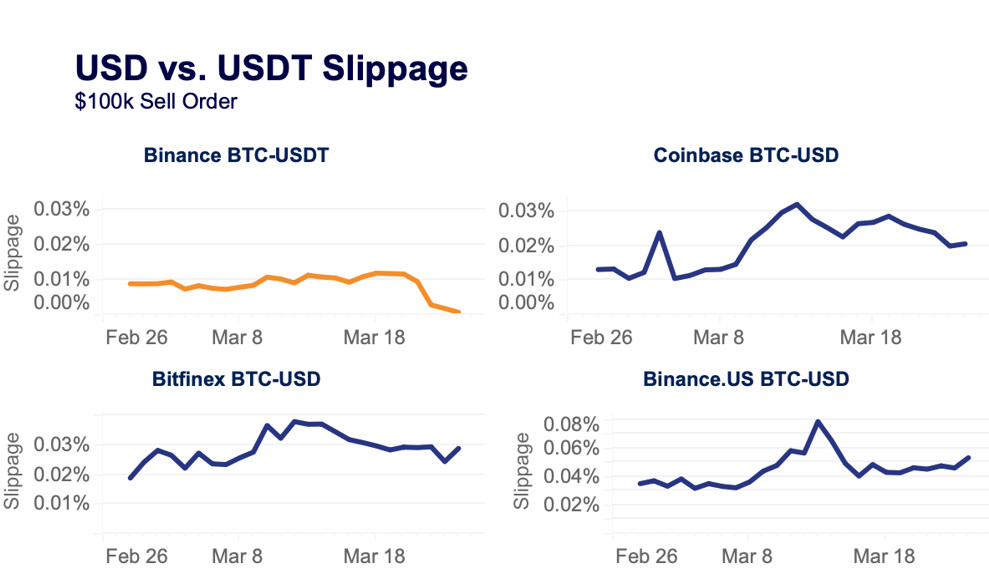A summarizing review of what has been happening at the crypto markets of the past week. A look at trending sectors, liquidity, volatility, spreads and more. The weekly report in cooperation with market data provider Kaiko.
Bitcoin continues to trade at 9-month highs after the Fed hiked rates by a quarter percentage point, suggesting increases are nearing an end. Crypto markets largely ignored news that Coinbase was served a Wells notice, the SEC charged Justin Sun with market manipulation, and Sushi received a subpoena from the SEC. Today we explore:
- The end of zero-fee trading on Binance.
- Depressed liquidity on Curve's 3pool.
- TRX wash trading allegations, visualized.
Binance liquidity in flux after removing zero fee trading
On March 22, Binance halted its no-fee trading promotion for 13 BTC spot trading pairs, reversing a move that helped boost the exchange’s market share by more than 20% relative to its competitors. The exchange also announced that it would be eliminating trading fees for the BTC-TUSD pair, which was mothballed in September and only recently re-listed. It is unclear why Binance has chosen to promote its TUSD pair, although it appears the exchange has selected the stablecoin as a successor to BUSD, which is being phased out because of regulatory actions in the U.S.
Ultimately, the impact of zero-fee trading on Binance cannot be understated. As of mid-March 2023, zero-fee trade volume accounted for a majority of total volume, clocking a high of 66%.
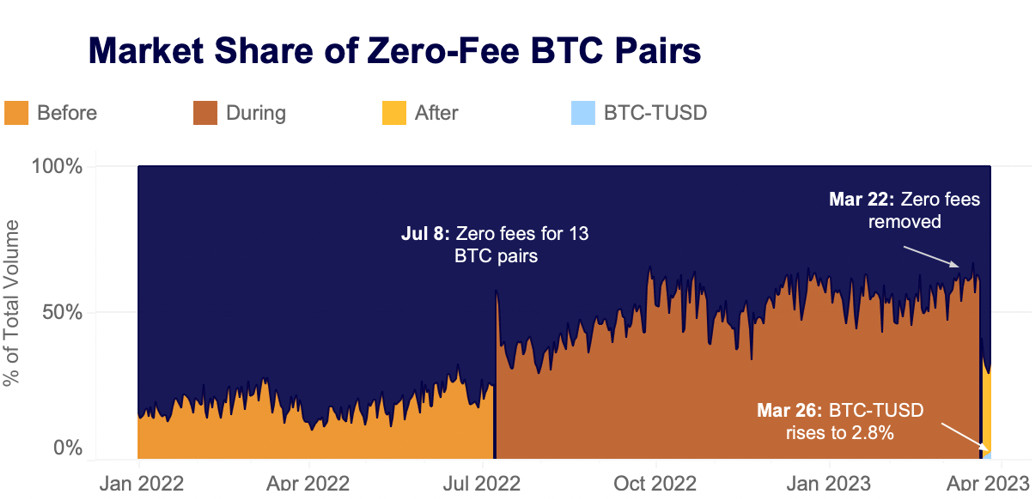
Before July 8 2022, the day zero fees launched, market share of volume for the 13 BTC pairs was just 25%. It has now been just 5 days since fees were reinstated, and market share has halved and is currently below 30%. The zero-fee BTC-TUSD pair now accounts for 2.8% of total volume.
Trade volume for BTC-USDT, the most liquid market in crypto, has been most impacted, with average volumes down a whopping 90%. Hourly volume for BTC-TUSD has climbed to ~$5mn, a significant increase but still minuscule relative to total volume.
Arbitrum small-caps surge on airdrop news, then fall
Arbitrum ecosystem tokens with smaller market caps surged following news that the layer 2 would finally be airdropping its ARB token. This airdrop was for users and protocols on the network, with GMX (token: GMX) and Treasure DAO (MAGIC) receiving the highest allocations of 8mn ARB each. Camelot DEX (GRAIL), a rapidly growing Arbitrum-native exchange, received 2.1mn tokens while Radiant Capital (RDNT), a cross-chain lending and borrowing protocol received 3.3mn.
While GMX and MAGIC did surge roughly 25%, this paled in comparison to newer and lower cap tokens like GRAIL and RDNT, which jumped 150% and 90% from their March 1 level, respectively. However, they peaked a day before the airdrop and have slumped post-airdrop as hype has dissipated and ARB has settled into a price range.
USD arbitrage opportunities are on the rise
Arbitrage between exchanges is becoming harder as the shut down of USD payment rails has made logistics challenging for some market makers, particularly on U.S. exchanges. As liquidity hits 10 month lows, price discrepancies between some U.S. exchanges become more frequent as volatility increases.
In 2022, prices on Binance.US tended to stay within a range of 0.1% of the average price across 10 other exchanges. This month, prices on Binance.US displayed far more discrepancies compared to other exchanges, regularly ranging outside a 0.2% difference and spiking past a 0.5% difference three times. Coinbase displayed similar price discrepancies this month with a higher range in differences and a couple of outliers as volatility picked up. Overall it seems the banking cutoff in the U.S. is affecting price homogeneity on U.S exchanges.
TRX wash trading identifiable in historical data
Justin Sun, the vocal founder of the Tron network, was just hit with a massive market manipulation lawsuit by the SEC, alleging an extensive wash trading program for the TRX and BTT tokens. The U.S.-based exchange Bittrex was specifically cited as one of the principal venues, so we thought we'd try to identify some patterns in the old historical data from 2018-19. The volume trends perfectly match up to the detailed report, with TRX market share abnormally spiking on the days the wash trades took place.
We can also identify artificial order book patterns using Kaiko's historical snapshot data. For a period of 3 months, the quantity of bids was always greater than asks, which suggests market makers were placing a bid wall to prevent downwards price movements. Typically, order book imbalances do not last for this long.
Ultimately, the lawsuit is no particular surprise, especially considering crypto wash trading was notoriously pervasive from 2017-2018. Since then, exchanges have improved their market manipulation detection systems and data providers have started publishing exchange transparency rankings.
Curve 3pool remains depressed following USDC's depeg
Does anyone remember when the second largest stablecoin dropped lower than $0.90 just a couple weeks ago? Crypto narrowly escaped what could have been one of its biggest market events ever, yet markets and narratives have continued to move along unbothered. But the ripple effects are still being felt.
Nowhere is this more obvious than Curve’s 3pool: one of the best barometers for stablecoin sentiment. Its TVL currently stands at just $420mn, down from $5.5bn in January last year. Additionally, the pool is composed of just 11% (under $50mn) USDT as users have opted to switch from USDC and DAI to the stablecoin with (apparently) no exposure to ongoing U.S. banking and regulatory issues.
ARB liquidity surges, settles into a range after listing
ARB trading began on most exchanges as soon as the token was airdropped. However, there was some difficulty for users to claim and move their airdropped tokens as the Arbitrum network became extremely congested and the Arbitrum Foundation’s claim site crashed.
Thus, in the first few hours of trading most centralized exchange pairs were relatively illiquid. It took 6 hours before 1% market depth (the sum of bids and asks within 1% of the mid price) hit nearly 2mn ARB. However, liquidity continued to grow over the weekend, hitting nearly 2mn, the vast majority of which is in USDT pairs. USD pairs have roughly double the liquidity as those included in Other (USDC, EUR, and BTC), at 325k to 160k, while USDT pairs hold 1.9mn ARB. Tether continues to be absolutely dominant in CEX trading.
Price slippage has increased on U.S. exchanges
For a $100k sell order in BTC markets, the most liquid USD pair (Coinbase) and the most liquid USDT pair (Binance) had similar slippage of 0.1% to start March. However, the fears over USD payment rails gripped liquidity markets in the U.S and we can see the spike in slippage around March 13 on Coinbase, compared to only a slight increase on the USDT pair on Binance. Slippage for the BTC-USD pair on Coinbase remains 2x higher than it was at the start of the month as USD liquidity suffers across the board in crypto markets.
The next most liquid BTC-USD pairs on Bitfinex and Binance.US both suffered from spikes in slippage, increasing 0.1% since the start of the month, with spikes of 0.2% and 0.4% respectively during the peak of the U.S. banking fears.

